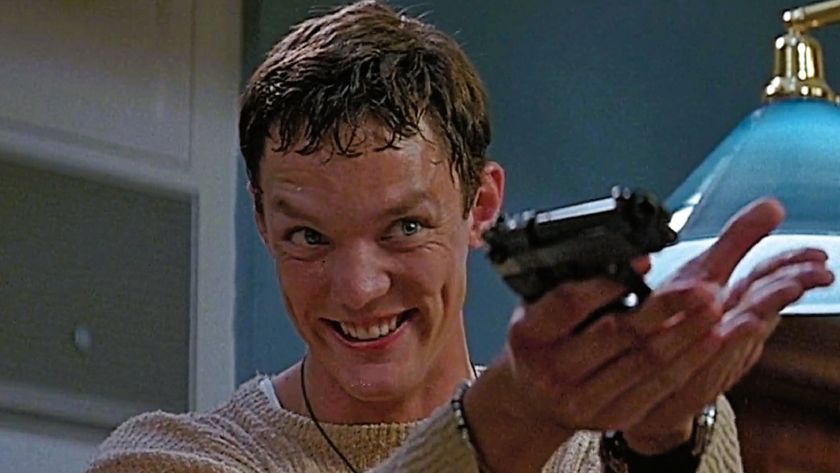The Story Behind Kung Fu Panda 2
Enter the panda
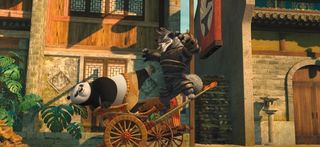
Kung Fu Kicks Back
“Since the release of Kung Fu Panda , there has been one burning question that people are desperate to answer,” says Panda 2's director Jennifer Yuh Nelson. “The question that defies explanation is: Why is Po’s dad a goose?”
It’s a head-scratcher, to be sure, especially since the Po in question is that film's eponymous panda. An irksome conundrum, and a fittingly oddball one for a film that came out of nowhere and surprised even the most ardent Pixar fans with its creative animation and winsome storyline.
Released in 2008, Kung Fu Panda amassed a colossal $633m worldwide, garnered warm reviews (“A master [ course ] in cunning visual art and ultra-satisfying entertainment,” said TIME ) and landed an Oscar nom in the Best Animated Feature Film category.
A return trip to ancient China and the world of Po (Jack Black) was pretty much a sure thing – and the seeds of a sequel had already been sewn in that paternity mystery.
“For Po, the Dragon Warrior, it was logical for him to finally realise his father is not his biological father and to seek his origin,” agrees Nelson. Adds producer Melissa Cobb: “We always imagined we had more story to tell with the continuation of Po and his journey...”
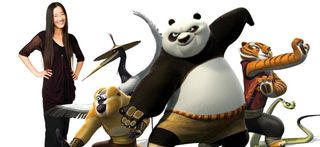
Direct To The Point
The first Kung Fu Panda was directed by John Stevenson and Mark Osborne. For Po’s second adventure, though, Nelson was hired to get behind the camera (so to speak).
Having worked on Panda 1 as Head Of Story, she was the perfect fit for the follow-up for more than a few reasons.
“I grew up with Hong Kong action movies,” says Nelson, “and I brought that sensibility as Head Of Story on Kung Fu Pand a. I was pretty gung ho for all of us to be in that mindset, and I continued that push on this film.
“I think one of the keys is that we’re all conversant in that vernacular now. And in working on Kung Fu Panda 2 , that shared experience has come with us, and it informs the story we are telling and the manner in which it is told. Our goal was to take Kung Fu Panda and Po to the next level.”
Producer Melissa Cobb was more than happy to give Nelson more responsibility this time around. “Jen was there from the beginning, and was really instrumental in helping to shape the story,” she says.
“If there is anyone who knows this material, these characters and this world, it is Jen. Her becoming the director of Kung Fu Panda 2 was the most natural progression imaginable.” Now they needed to flesh out a story...
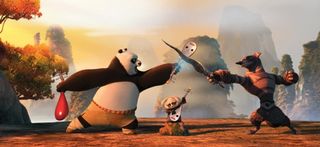
Moving On
Nelson was adamant about one thing – she didn’t want a sequel to stand still (even in a crane pose). And the new director had very definite ideas of what a follow-up to Kung Fu Panda should involve.
“In the first film,” she says, “we learned that heroes come in all shapes and sizes as Po fulfilled his destiny and became the Dragon Warrior.
“In the sequel, we learn that fate leads us to our destiny – bringing people into our lives that protect us and those that challenge us... allowing us to realise our full potential.”
Producer Cobb felt the same, knowing that the key to making a good sequel would be making it “timeless”, not to mention respectful to the kung fu genre that spawned it.
“We knew when we made the first film that we created a character with a lot of depth and levels of story we weren’t able to touch on,” Cobb says. “What we have in the sequel is the evolution of a hero - which isn’t a straight path, or a standard arc. And evolution takes time, so we’re committed to going with Po on his journey.
“When Kung Fu Panda 2 started to take shape, it was an organic extension of the story that we began.” Time to get the writers in...
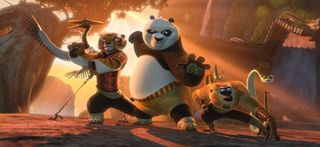
Writers Return
Screenwriters Jonathan Aibel and Glenn Berger both returned to help Nelson continue the story of Po and his comrades, and were thrilled at the prospect of diving into Po’s origins.
“Working on the first, it was fantastic, a giant collaboration,” enthuses Aibel. “I think the best thing we can say about the group of people working on the first movie is that they all wanted to be a part of the second movie.
“That’s pretty rare in Hollywood. I mean, the heads of nearly every department on this movie were in the same job on the first movie. People say once they started working for Po, they didn’t want to leave."
In terms of developing Panda 2 in exciting new directions, the writer adds that “a lot of creative energy [ went into pushing ] the limits and seeing how much more fun we could have - this meant bigger action sequences, deeper character work, a larger look at this amazing world”. Pivotal to all this, of course, was Po...
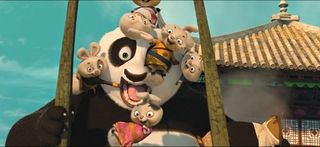
Po Faced
Jack Black voiced lovable panda Po in the first Kung Fu Panda , a film that saw the big bear evolve from klutz-y nobody to fierce fighter. And nobody was more pleased with Panda 1 than Black.
“When I finally saw the whole thing put together it was one of the proudest moments of my career,” he reveals.
“It takes many years to make one of these movies - a lot longer than a regular live-action film. There’s much more work that goes into it - story development, artwork, particularly the way the DreamWorks Animation filmmakers work on their films.”
Black got confirmation of Po’s importance to everybody else when he recently visited the Atlanta Zoo.
“[ I went to ] see the latest panda born in captivity, and they named him Po. Wow. I’d say that’s a pretty big deal. He’s not ready for a throw-down yet, but give him time. He’s gonna be one heck of a panda, I just know it.” So where is our kung fu hero when we catch up with him?
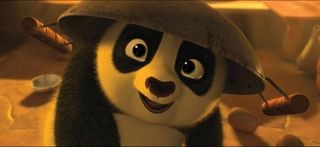
Po Ponders
“Now, Po is having flashbacks of his childhood, before he lived with his father, who’s a goose,” Black says.
“So he comes to realise that he’s actually adopted, and he doesn’t know where his birth parents are or what happened to the other pandas. Why did they give him up? So in addition to this being a hero’s journey to save the day, it’s also a journey of self-discovery.”
Kung Fu Panda 2 is careful not to trample on anybody’s toes, though, approaching the tricky topic of parenting in a typically candid, heartfelt way.
“Once Po suspects that he’s adopted, he confronts his father, who admits that he found him when he was a baby,” says Black. “But he raised him as his son, and he considers him his son.
"Po believes that, too, but he still wants some questions answered. And it just so happens that these questions arise at the same time that a new villain, Lord Shen, the peacock, arrives on the scene. Mysterious, no?” Very mysterious...
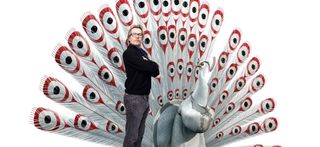
Kick Him In The Shen
How do you top a villain like Tai Lung, the antagonistic snow leopard from Panda 1 ? Well, you don’t. You do the complete opposite. Where Panda 1 had super-powerful fighter Tai Lung, Panda 2 sees Po facing a foe with serious brainpower .
“We felt we couldn’t top Tai Lung if we tried to come up with an even stronger villain,” explains co-writer Aibel, “so we thought, ‘What if we tried to make this villain more threatening in an intellectual and an emotional way?’ So that’s how we came up with the character of the albino peacock, Lord Shen.”
As Nelson reveals, Po “learns his past is tied to Lord Shen. The peacock’s challenge is not random, it is the working of fate - something that figures prominently in martial arts films. And it is only when he learns the truth about who he is that Po is able to confront Shen and his army.”
Who to voice such a cunning, evil genius? Only one man fit the bill. “I love the challenge of conveying a character fully just using the voice,” says Gary Oldman. “And Shen is a particularly interesting character. I think he fits very nicely in the gallery of Oldman villains.”
Adds Nelson: “He’s sinister and scary in his own way.” Sounds like Po’s going to need back-up...
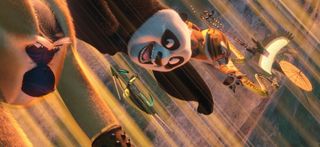
Furious Five
As any decent filmmaker will tell you, the good thing about a sequel is that all the groundwork has already been laid, meaning there’s more room to explore the established universe.
For the minds behind Kung Fu Panda 2, that exploration meant more screen time for the Furious Five. The most skilled fighters in China, they take their names from the five Chinese martial arts - Crane, Snake, Monkey, Praying Mantis and Tiger.
“In the first film, we were busy telling the story of Po’s training with Shifu,” says co-writer Berger, “so we didn’t get as much time as we wanted to with the Furious Five.
“But now, we have the great opportunity to have them along on this journey with Po and have them in more scenes, which meant more time to write for [ them ].
"For any writer, any one of those would be enough. But to have five of them along in all these scenes is just a great opportunity for us.” Here comes the reunion part...
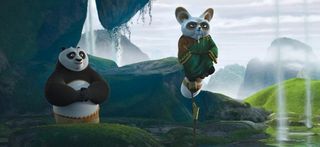
Familiar Faces
This being a DreamWorks animation, the voices of the Furious Five are all provided by some very big Hollywood names. Among them is Dustin Hoffman, who returns to voice Master Shifu.
For Hoffman, coming back for Panda 2 was no challenge whatsoever. “Providing the voice of Shifu again was like slipping into a comfortable robe, assuming a meditative pose and settling into a tranquil state of mind,” he says.
“That pretty much describes the atmosphere created by the wonderful filmmakers at DreamWorks Animation, as well.”
Meanwhile, a kung fu film is nothing without Jackie Chan, who provides the voice of Monkey. “It’s so much fun playing Monkey that it doesn’t even feel like a job,” he says.
“We’re very much alike - we’re good at martial arts, and we can use joking as a screen, to hide the fact that before our opponents know it, while they’re laughing, we’ve beaten them. But then a lot of times, I just joke for fun.” Then there’s Tigress...
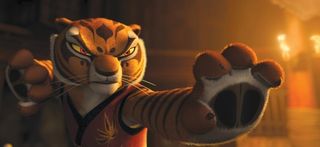
Tame The Tiger
Only one actress could possibly embody both the sultry demeanour of Tigress as well as her kick-ass, ball-busting action (for lack of a better word) kahunas. And that actress is Angelina Jolie, who returns to play the South China tiger.
“First and foremost, Tigress is a fighter, and she’s out to get the bad guy,” Jolie says of her character. “But what’s nice about this story is that she has a bit of a breakthrough and learns to be nicer.
“Her pride was wounded when she was not chosen to be the Dragon Warrior, and it took her a while to get over being angry at Po and the universe, in general.”
For co-writers Aibel and Berger, Panda 2 gave them the chance to find new avenues through which to explore Tigress.
“What if Tigress had this softer side to her?” asks Abiel. “To be able to give that to Angelina and see what she did with it was great to witness.
"Sometimes, it takes an animated character to show a different side of an actor. As a voice performer, you’re free from people’s expectations of what they’ve seen from you in live-action films.”
With Seth Rogen (Mantis), Lucy Liu (Viper) and David Cross (Crane) also all back, Panda 2 was definitely on the move...
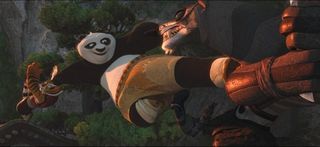
Can We Get A Training Montage?
Kung Fu Panda and its sequel may be animated movies that merely require an actor's voice (and an army of animators), but Jack Black reveals that didn’t keep him from signing up for a few kung fu lessons.
“Yes, I did some training in kung fu, for both films,” Black admits. “It wasn’t just for research purposes, it was also to kind of get in shape.
“What really drew me is that there’s a combination of exercise and self-defence, along with a third, sort of unseen, component: a spiritual one.
“When you’re really practicing kung fu, living it and feeling it, there’s a meditative quality that seeps in. It feels almost religious. It’s an art form, really. Oh, well, duh, it’s called martial arts.”
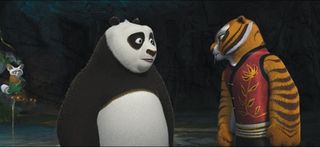
Action!
On top of tunnelling deeper into its characters, Panda 2 faced a particularly difficult challenge where the action was concerned.
As Black says: “The amazing sequences they had with Tai Lung in the first film, I just really didn’t get how they would top those. They were mind-blowing.
“But that’s what [ director ] Jen and everybody set out to do, and that’s what they did. Not only the kung fu got kicked up a notch, but so did the sets.”
For her part, Nelson wanted to seize the new opportunities in CG movies, with the medium having developed exponentially since the first Panda .
“The effects that we can accomplish now are much more advanced than just a couple of years ago, particularly with the added layer of 3D,” she says. “So we were able to go pretty much where we wanted to with the action.” Yes, she did just say 3D...
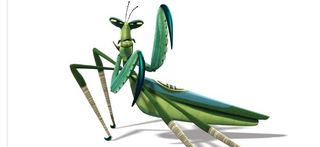
3D
With 3D all the rage, Panda 2 was always going to be a part of that most eye-popping of mediums.
Editor Clare Knight welcomed the new challenges 3D posed, embracing the expanded canvas that the format offered Panda 2 .
“The thing about 3D, I find, is that it’s substantially more immersive,” Knight says. “For me, editing in 3D, I have to look at so much more within the screen. Moviegoers will get to see a whole lot more. So now, even more care is taken.
“I have to really look at how the eye is informed across the cut. Too much, too fast, the classic headache and eye fatigue. It really is a much bigger challenge, but that makes it all the more exciting to work on.
“And in this world, it’s beautiful, and it serves both the action and the incredible environments we’ve built. It’s the ultimate, and very exciting for the storytelling process.”
Adding to the richness of the movie, Nelson and her crew actually visited China in order to soak up the culture. There, she visited the ancient walled city of Pingyao as well as Beijing, and feels it benefited the film massively.
“Being in China was amazing,” she says, “because there’s a certain level of tactile knowledge of a place that you’ll never get from a book.
"Actually being there and feeling what the air feels like, or the way the light hits the side of a building or a tile; there are all these tiny details that really push the movie forward...”
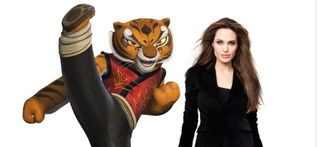
Kung Fu Fighting
Kung Fu Panda 2 smashes its way into cinemas this Friday (10 June 2011). It has already been playing in the US for just over a week, and has earned massively favourable reviews. Though it opened at number two at the box office, it has already nabbed $100m in ticket receipts.
So what is it about Kung Fu Panda that has so many people – and not just kids – demanding more?
“The movie was so fun and cool and hip, but it also had a sense of history and culture,” muses Jolie. “It was also this moral tale of how to behave, how to treat your friends, which makes it more like a classic animated film.
“But mostly, it has Jack Black, which I feel is the main reason people went to see it - it would be my reason! He’s so funny, and the dynamic between him and the Five, it’s almost a classic dysfunctional family.”
Josh Winning has worn a lot of hats over the years. Contributing Editor at Total Film, writer for SFX, and senior film writer at the Radio Times. Josh has also penned a novel about mysteries and monsters, is the co-host of a movie podcast, and has a library of pretty phenomenal stories from visiting some of the biggest TV and film sets in the world. He would also like you to know that he "lives for cat videos..." Don't we all, Josh. Don't we all.
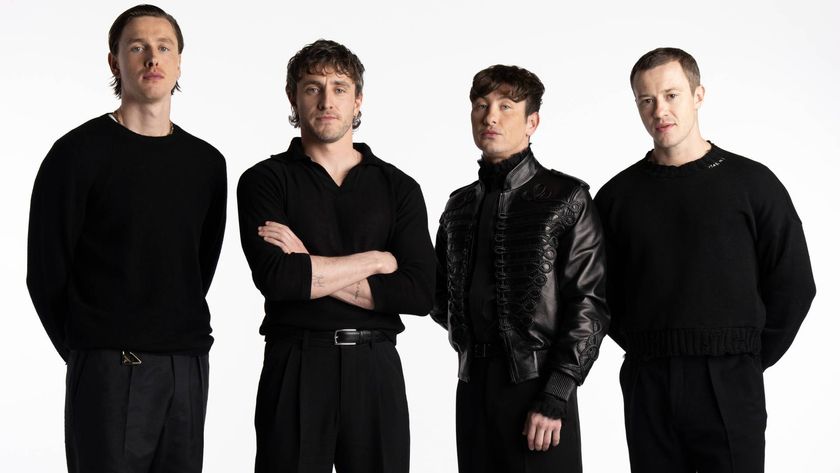
Gladiator's Paul Mescal and Saltburn's Barry Keoghan finally confirmed for the long-rumored Beatles cast in a first look announcing the wildest release strategy
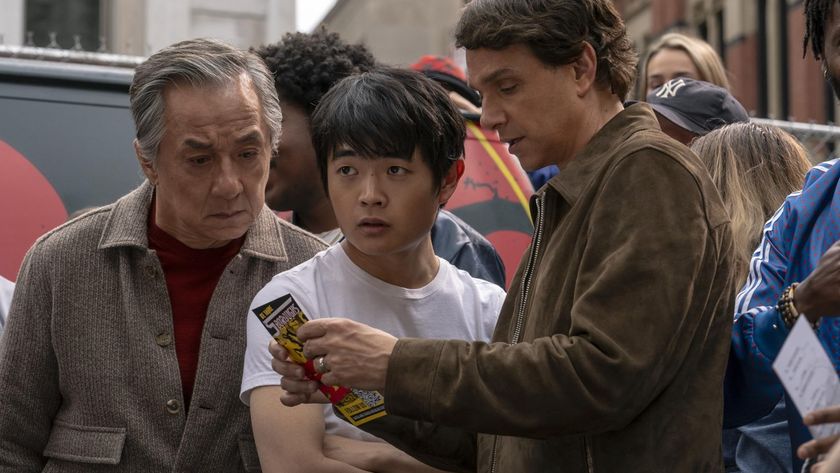
Karate Kid: Legends releases new trailer featuring intense fights, a lot of Karate Kid nostalgia, and Peter Parker comparisons

Gladiator's Paul Mescal and Saltburn's Barry Keoghan finally confirmed for the long-rumored Beatles cast in a first look announcing the wildest release strategy

Karate Kid: Legends releases new trailer featuring intense fights, a lot of Karate Kid nostalgia, and Peter Parker comparisons
